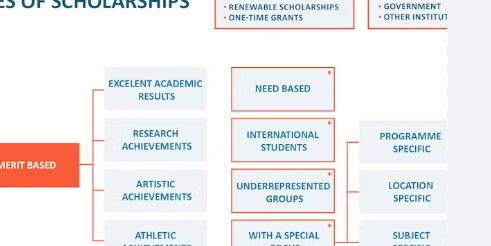Scholarships 101: Everything You Need to Know to Fund Your Education

Title: “Scholarships 101: Everything You Need to Know to Fund Your Education” Introduction: In an era where the cost of education continues to rise, scholarships represent invaluable resources for students aiming to pursue their academic dreams without the burden of overwhelming debt. However, navigating the complex world of scholarships can be daunting. From understanding eligibility criteria to mastering the application process, “Scholarships 101” serves as your comprehensive guide to securing funding for your education. Whether you’re a high school senior
planning for college or a graduate student seeking financial aid, this guide will equip you with the knowledge and strategies needed to unlock opportunities for academic success. Chapter 1: Demystifying Scholarships Defining Scholarships: What are scholarships, and why are they important? Types of Scholarships: Merit-based, need-based, athletic, minority scholarships, and more. Understanding Eligibility: Criteria such as GPA, standardized test scores, extracurricular activities, and demographics. The Benefits of Scholarships: Financial assistance, recognition, networking opportunities, and academic support. Chapter 2: Researching Scholarship Opportunities Online
Resources: Websites, databases, and search engines tailored to scholarship seekers. Local and National Opportunities: Exploring scholarships offered by schools, communities, organizations, and government agencies. Niche Scholarships: Specialized awards for specific interests, talents, or backgrounds. Reading the Fine Print: Paying attention to deadlines, requirements, and restrictions. Chapter 3: Crafting a Winning Application Personal Statement: Writing compelling essays that highlight your achievements, aspirations, and values. Letters of Recommendation: Choosing the right recommenders and guiding them to showcase your strengths. Resume Building: Presenting a comprehensive overview of your academic and extracurricular accomplishments. Application Tips: Strategizing time management, seeking feedback, and proofreading meticulously. Chapter 4: Maximizing Your
Chances of Success Diversifying Your Portfolio: Applying for multiple scholarships to increase your odds of receiving funding. Tailoring Applications: Customizing materials to align with each scholarship’s mission and criteria. Leveraging Your Strengths: Showcasing unique talents, experiences, and perspectives. Persistence and Resilience: Learning from rejections and staying motivated throughout the application process. Chapter 5: Navigating the Post-Award Process Accepting Scholarships: Understanding terms, conditions, and obligations associated with receiving funding. Thank You Letters: Expressing gratitude to scholarship providers and donors. Maintaining Eligibility:
Fulfilling requirements to retain scholarships and avoid potential pitfalls. Paying It Forward: Giving back to the community and supporting future scholarship seekers. Conclusion: “Scholarships 101” empowers students with the knowledge and tools needed to pursue educational opportunities without financial barriers. By demystifying the scholarship landscape, providing practical tips for success, and encouraging a spirit of resilience and gratitude, this guide equips readers to navigate their academic journeys with confidence and ambition. Remember, with determination and resourcefulness, the path to funding your education is within reach.Chapter 1: Demystifying Scholarships Defining Scholarships: This section not only defines scholarships but also explores their historical
context, tracing the evolution of scholarship programs and their significance in promoting access to education. Types of Scholarships: In addition to discussing the different categories of scholarships, this part delves deeper into each type, providing examples and case studies to illustrate how various scholarships have impacted students’ lives. Understanding Eligibility: Beyond listing eligibility criteria, this section provides insights into how scholarship committees evaluate applicants and make decisions. It discusses common misconceptions about eligibility and offers advice for students who may not meet all criteria but still wish to apply. The Benefits of Scholarships: This section goes beyond the tangible benefits of scholarships to explore their broader impact on society. It discusses how
scholarships contribute to social mobility, diversity, and workforce development, highlighting their role in building a more equitable and prosperous future. Chapter 2: Researching Scholarship Opportunities Online Resources: In addition to listing websites and databases, this part offers tips for using search filters effectively and staying organized when researching scholarships online. It also discusses the importance of verifying the legitimacy of scholarship opportunities to avoid scams or fraudulent schemes. Local and National Opportunities: This section provides strategies for tapping into both local and national scholarship pools, emphasizing the value of community connections and networking. It also discusses how students can leverage their personal networks and advocate for themselves when seeking scholarship opportunities. Niche Scholarships: Beyond introducing niche scholarships, this part explores the impact of identity-based scholarships on underrepresented groups and marginalized communities.
It discusses the importance of equity and inclusion in scholarship programs and highlights initiatives aimed at addressing systemic barriers to access. Reading the Fine Print: In addition to discussing deadlines and requirements, this section provides guidance on interpreting scholarship terms and conditions, including clauses related to scholarship disbursement, renewal, and termination. It also offers tips for communicating with scholarship providers and seeking clarification when needed. Chapter 3: Crafting a Winning Application Personal Statement: This part offers in-depth guidance on brainstorming and structuring personal statements, including exercises and prompts to help students articulate their goals and aspirations. It also discusses the role of storytelling and authenticity in crafting compelling narratives that resonate with scholarship reviewers. Letters of Recommendation:
In addition to selecting recommenders, this section explores strategies for building strong relationships with mentors and advisors who can provide meaningful endorsements. It also discusses the importance of reciprocity and gratitude in fostering supportive academic communities. Resume Building: Beyond listing accomplishments, this part discusses how to strategically organize and present information on resumes to highlight key achievements and skills. It also explores the role of digital portfolios and online profiles in supplementing traditional resumes for scholarship applications. Application Tips: In addition to time management strategies, this section offers advice on mitigating stress and managing expectations during the application process. It also provides guidance on troubleshooting common challenges such as technical difficulties or conflicting deadlines. Chapter 4: Maximizing Your Chances of Success Diversifying Your Portfolio: This part explores strategies for balancing quantity and quality when applying for scholarships, including tips for prioritizing applications based on fit and alignment with personal goals. It also discusses the importance of self-care and maintaining a healthy balance between scholarship pursuits and other commitments. Tailoring Applications: In addition to discussing customization strategies, this section
provides examples of successful scholarship applications and analyzes how applicants have effectively tailored their materials to different audiences. It also offers insights into the role of personal branding and storytelling in shaping scholarship narratives. Leveraging Your Strengths: This part explores the concept of strengths-based scholarship applications, emphasizing the value of self-awareness and reflection in identifying unique attributes and experiences. It also discusses the role of resilience and adaptability in overcoming setbacks and challenges. Persistence and Resilience: In addition to discussing coping strategies for dealing with rejection, this section explores the concept of growth mindset and its implications for scholarship success. It also offers tips for building resilience through community support, mentorship, and ongoing learning. Chapter 5: Navigating the Post-Award Process Accepting
Scholarships: This part provides guidance on navigating scholarship acceptance processes, including negotiating terms and conditions, understanding financial aid implications, and managing expectations for scholarship disbursement. Thank You Letters: In addition to discussing etiquette and professionalism, this section explores the emotional impact of expressing gratitude and its role in building lasting relationships with scholarship providers and donors. Maintaining Eligibility: This part offers strategies for staying on track and meeting ongoing scholarship requirements, including time management techniques, academic planning, and proactive communication with scholarship administrators. Paying It Forward: Beyond discussing the benefits of giving back, this section explores
concrete ways in which scholarship recipients can contribute to their communities and support future generations of scholars, including mentoring, volunteering, and advocating for educational equity. Conclusion The conclusion of the guide reflects on the transformative power of scholarships and the potential for positive change they represent. It encourages readers to continue their journey of scholarship pursuit with confidence and determination, knowing that they have the knowledge and resources to succeed. It also emphasizes the importance of collective action in advancing educational equity and creating opportunities for all students to thrive.





